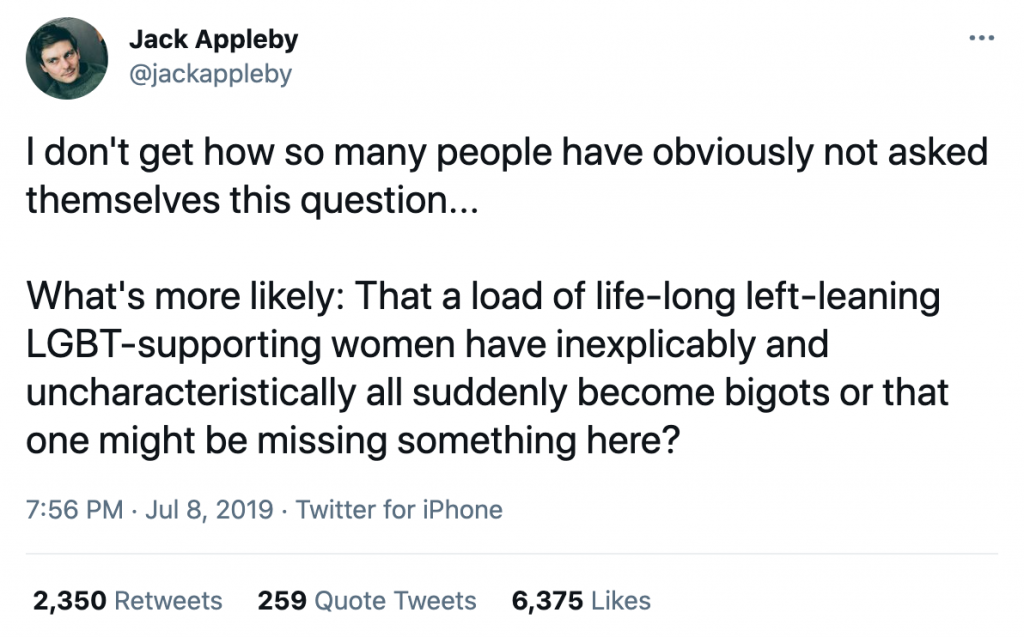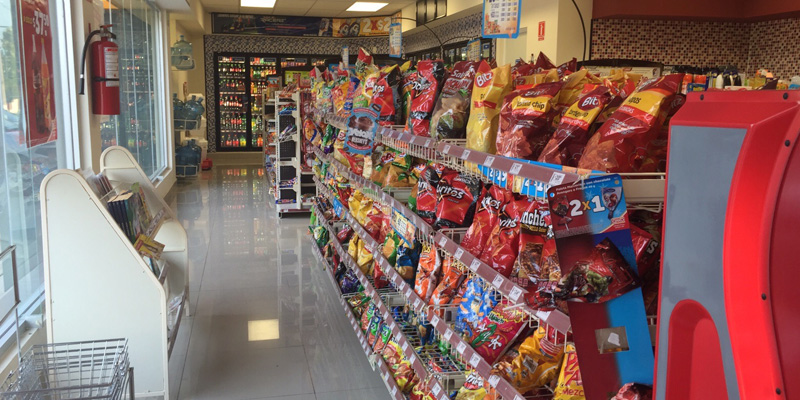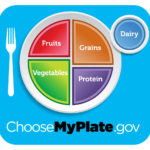A friend recently emailed me an article titled Transgender woman convicted of sexually assaulting 10-year-old girl, and wrote “This will eventually happen in a public bathroom or women-only space. My guess is a lawsuit against the city or company is inevitable, in the US.” Like quite a few women I know in the animal rights movement, this friend knows of my views on gender ideology and falls somewhere on the spectrum from “finds my gender critical remarks reasonable” to “is very alarmed by the advancement of gender ideology”, but doesn’t share her views publicly. The animal rights movement has wholeheartedly embraced woke culture which has been harmful to the movement in a number of ways, including by reinforcing the sexism in its midst. Female animal advocates have to make a choice between speaking up for animals or for women. When I started speaking openly about gender identity a few years ago, I became a safe person for others to share a “WTF” moment with, and I’ve seen that the WTF alarms are ringing for more and more people.
Nonetheless, I can’t say I’m optimistic that things are really changing, that the small wave of WTF thought bubbles is strong enough to counter the well funded, expertly marketed tsunami of a pushback against feminism that we are experiencing. It is deeply deflating to witness the incapacity or unwillingness to engage in basic logical reasoning. The seemingly unmovable and unquestioned sexism–including in the supposedly progressive West, including among those expected to care about the oppressed. The effectiveness with which everything revolutionary gets co-opted, including the feminist movement. The incredible level of conformity from vegans of all people, the very same minuscule minority who supposedly have the courage to stick their necks out for animals. The trifecta of stupidity, misogyny and cowardice leaves little room for hope.
I emailed my friend back that these things had already been taking place, that there were known cases of men raping women in female prisons. I attached the article, Women’s boundaries shouldn’t only matter when politically correct, written after the tragic murder of Sarah Everard, and copied this passage:
‘Many of those taking to Twitter to tell us to #BelieveWomen and #YesAllWomen very quickly forget these principles the moment it counts. If you don’t believe me, try telling your progressive circle of friends that male sex offenders should not be housed in women’s prisons. You could add that women have allegedly been raped as a result of this policy, as any fool could have predicted. Rather than justified feminist outrage, you will likely be met with embarrassed silence at best, or some hemming and hawing about how it’s a “difficult issue;” or, at worst, ostracism and accusations of bigotry. Middle class women are allowed to be afraid to go jogging after dark, but there is no sympathy for incarcerated women — some of the most vulnerable members of society, large numbers of whom have prior trauma at the hands of males — who are now locked up with convicted rapists. Any concern raised is just hateful scaremongering masking a conservative agenda.’
Liberals have erected what seems like an impenetrable mental fort around the trans issue and it is supported by other elements beyond the stupidity, misogyny and cowardice. What is it that makes people refuse to consider that they might not be “on the right side of history”? Hubris, definitely. Racism too; it goes with the hubris.
The unwillingness of many liberals to question the framing of “their side” or to take a peek at others’ arguments is facilitated by the fact that these others are systematically denied a platform, and those who do succeed in getting some visibility are relentlessly smeared as hateful transphobes. How many people actually read JK Rowling’s letter or Abigail Shrier’s book before accepting as fact that they are raving bigots? The go-to news outlets and influencers tell them it’s so, and they can’t all be wrong can they? Opposition to gender ideology is painted as coming exclusively from the religious right, which fits nicely into the black-and-white, us-v-them, “we’re enlightened and they’re all backwards racists” worldview common in the US. People who opposed civil rights for homosexuals were bad guys and trans is the next civil rights frontier, right? We’re going to make sure to be the good guys this time, dammit.
In reality, much (perhaps most) of the resistance to gender ideology comes from lesbians and gays (many of whom built the LGBT movement), long-time feminist activists (gender as something socially-constructed and separate from sex was conceptualized by feminists) and others who have been involved in a number of progressive causes.

For a liberal who has waited this long to question the gender ID movement, it is threatening to start questioning it now. Or to question one’s own opinions – what do I really mean when I say that trans women are women? – because the whole house of cards would come down. So they hold on by looking around them and finding reassurance that their crowd still thinks like them. It’s just herd mentality. Not only will liberals simply not entertain the possibility that they might in fact be the reactionary, bigoted party, they also don’t relish considering that the causes they’ve championed were chosen not through reason but social conformity. The longer this goes on, the more you resist telling yourself, Man, I guess I’m a sheep. This vicious circle is basically a social conformist’s sunk cost fallacy.
As ignorant as liberals might be about an issue, they still know for sure that theirs is the side of equality and greater acceptance (and most are ignorant about the beliefs and demands of the gender ideology movement, and think they are on the side of the gender non-conforming when in fact it’s the opposite). At an individual level, the conviction that one is tolerant and righteous and on the right side of history is rooted in hubris–that unshakeable notion that I’m a GOOD PERSON (TM). At a collective level, it translates to the belief that WE’RE civilized. When you explain the extent of the backlash and loss of rights suffered by women, it doesn’t land because for it to do so there would need to be an understanding that, here too, we live in a patriarchy. Libfems make vague and reprobative references to some of the ills of patriarchy, but there is still a pro-Western bias wherein it is believed that, here in the West, we are fundamentally a progressive society and that most men truly favor equality. To see the homophobia and misogyny of the gender ID movement would require seeing the homophobia and misogyny of our society at large; it would require a fundamental shift in worldview.
A lot has been said and written about Iran’s “tolerant” attitude towards transgender people. Below is a 2014 BBC documentary that makes the case that in Iran, homosexuals often choose to medically transition due to fear, pressure and lack of information and other options. Shadi Amin, a coordinator with the Iranian Lesbian and Transgender Network (6Rang), says, “A lot of people think that Iran is the paradise of transexuals, but I say it’s the hell of homosexuals”. Her quote is at 29:59, but please watch the whole video. While homosexuality is not illegal in the West, other experiences that they identify as driving some homosexuals to transition are similar to what is happening in the West. The lack of acceptance and visibility of lesbians is often echoed in the personal accounts of Western female detransitioners. The pseudoscientific nonsense underpinning these projects is the same everywhere. What does it mean for a doctor to tell an effeminate gay man that he is “98% female” and that they can change the 2% to make him fully a woman, but they can’t change the 98% to make him a man? [see Marie’s story at 30:35] Do 98% of the cells in his body have XX chromosomes? No, what it means is that to be a “real man” one can not be attracted to men and prefer the activities or mannerisms that a patriarchal society prescribes to women. Therefore, one’s male body is the “2%” of the equation, but one’s soul and personality are really those of a woman. This is in line with the official view of the Iranian state that gay people have a mismatch between body and soul: gay men have a woman’s soul in a man’s body, lesbians have a man’s soul in a women’s body. It’s also in line with the view of gender ideologues in the West. How is the Iranian therapist different from Dr. Diane Ehrensacht, a San Francisco clinical and developmental psychologist and leader in the field of pediatric transgenderism, who considers that a female toddler tearing out her barrettes is a sign that she’s really a boy? In the UK, therapists at a child gender clinic famously said “it feels like conversion therapy for gay children” and reported that “there was a dark joke among staff that there would be no gay people left”.
Again, this narrative about Iran is not obscure. It could have invited some self-examination on the part of Westerners. But chauvinism goes hand in hand with racism, and conceptualizing the other as backwards preemptively dismantles any comparisons. They’re stuck in archaic oppressive traditions–but when we do the same thing, it’s totes progressive.
Gender ideology is being exported and pushed onto the rest of the world by the West, especially by the Anglosphere. Linda Louis is an Indian feminist with a background in international human rights law. In this presentation, she speaks of the neocolonialism of the gender identity movement. She notes that various UN agencies all agree that women need access to separate toilets, “but somehow, this is forgotten when it comes to developed countries as if the girls in developed countries are not eligible for the very same basic facilities that the United Nations recommends for developing countries”. She says that it’s like a “reversal of human dignity” because what is afforded to girls in the Global South is being refused to girls of the Global North. “Reversal”, because the usual pattern is that we afford dignity to those in the Global North and not South. But the way I read this is that men of the Global South are seen as predatory, while men of the Global North are not. Not much of a reversal. Though the corollary is that when women in the Global North (those wretched “white feminists”) speak of fear of male violence, they’re just pearl-clutching prudes and bigots.
If you’re curious about my claim that there have been attacks on women in prisons, these cases are compiled on the website Women are Human. I’m sure that the fact of this compilation will be construed by genderists as proof of fear-mongering and victimization of trans-identified males by feminists, but the point is that the violence that we know men commit at higher rates than women doesn’t magically disappear when a man declares himself a woman.
The data we have on male violence against women is on the basis of SEX, not gender identity. And we have no reason to believe that men’s gender identities are correlated with their propensity towards violence. If transactivists want to make that case, they should provide the data. If we have reason to create spaces from which we exclude men (or males/male-bodied people/the scrotal half/prostate-havers/bepenised ones/AMAB/XY people or whatever your choice of words may be) there is no reason to make exceptions for men who have special gender identities. But that’s the crux of it, isn’t it? Liberals don’t believe or don’t care that we have reason for such spaces. We’re back at square 1, having to argue for our gains all over again.






